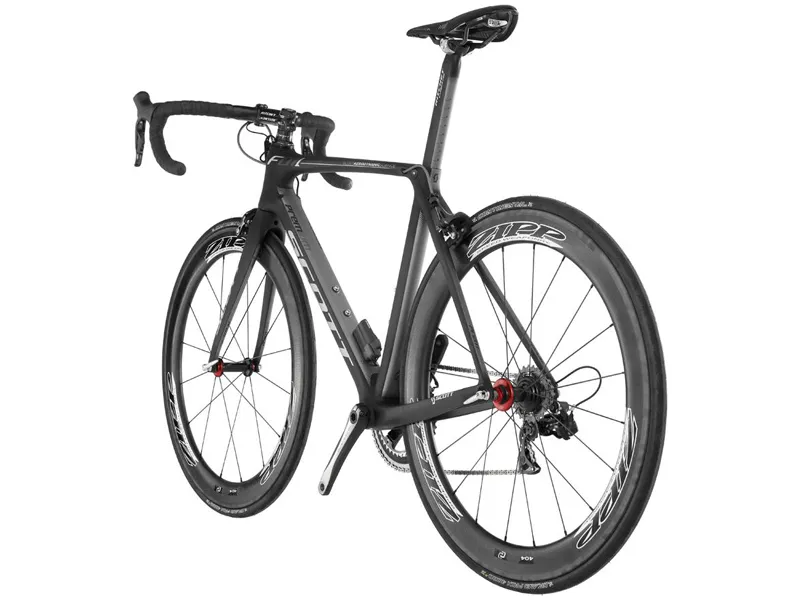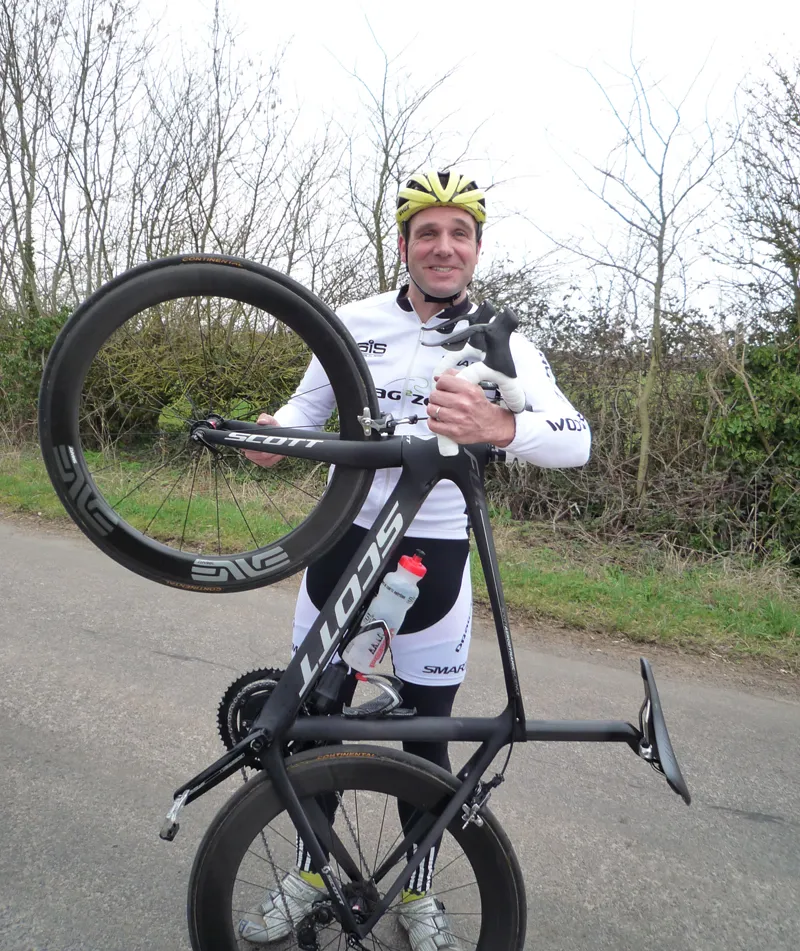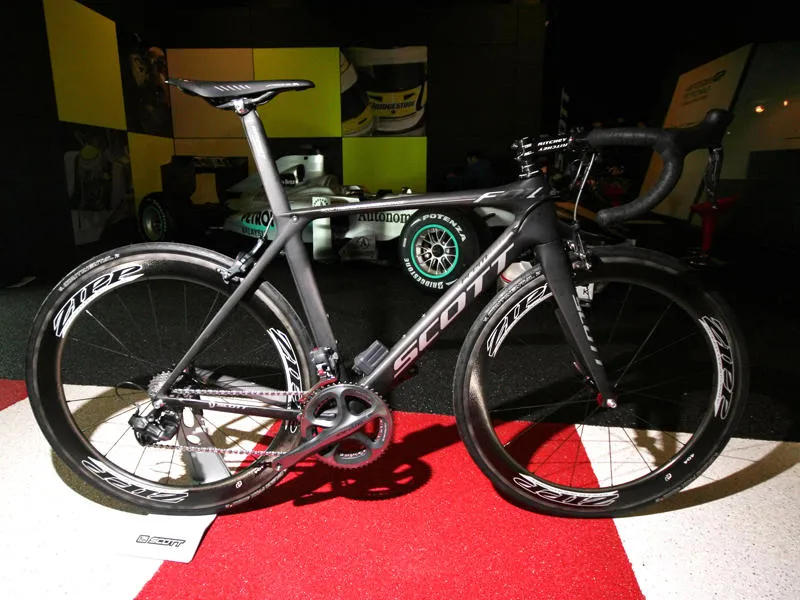The Scott Foil is one of the most eagerly awaited bikes of the year. Prototypes were first seen at the 2010 Tour de France, but when Specialized launched the Venge a month ago Scott were almost foiled before they’d started.
The original project was codenamed F01. Scott have since found an L down the back of the sofa and the production bike is called the Foil, as in airfoil. The top tube graphic still says F01L, though, which looks like a fencer’s personalised numberplate. That aside, it’s a great looking bike – more so than in pictures.
We managed to wrangle a ride on aerodynamicist Simon Smart's bike. The spec was similar to the top-end (€9,500) Foil Premium production model (pictured), with Shimano Dura-Ace Di2. Differences included prototype ENVE Composites wheels instead of Zipp 404s, and an SRM power meter.
Ride & handling: Fast and free from compromise
It’s almost impossible to gauge a bike’s aerodynamics by feel – there are far too many variables involved – but this is definitely a fast bike. It’s stiff too, with no sensation of flex even when sprinting up short climbs out of the saddle and pulling hard on the drops.
We rode the Scott in Lotto-win spec, with Di2 and deep-section carbon wheels, and we took one of our own bikes along for direct comparison – a very stiff and light Trigon RQC-29, which was fitted with identical wheels to create a fair comparison.
Repeatedly jumping from one to the other established that the Foil definitely provides an advantage and wastes none of your effort. It isn’t especially comfortable but it filters out the worst of the road surface irregularities.
Handling is surprisingly calm for a pro tool, with the sort of reassuring stability you might expect from a sportive bike. We were told that stability at high speeds, especially in a sprint, was deemed more important by Scott's sponsored riders than extreme agility.
Quick changes of direction require slightly more input than you might be used to but it takes no time at all to adapt. The payoff is when you reach a fast corner and the Foil rails around it with complete composure.
We’ve ridden the Cervélo S3 a fair bit and spent a lot of time on Felt’s AR1. Like the Scott, both give you that slight feeling of having good legs, with 20mph speeds on the flat seeming easier to maintain than normal.
Scott claim that the Foil is the most slippery of the three but even their data suggests that it’s by such a minimal amount that it could only be measured in a wind tunnel. All three claim to save you in the region of 20 watts at 40kph (24mph). There are crucial differences though.
Until now, making a bike aero has always necessitated compromising either stiffness, weight or comfort, and sometimes all three. In contrast, the Foil is around 200g lighter than the S3, and also stiffer, according to Scott.

A more tangible benefit is the handling. When we tested the Cervélo against other superbikes it lost out for being too aggressive. The Foil marginally outperforms the S3 in the lab and also makes that performance usable to more riders.
We rode a Felt AR1 the day after the Foil. The frame is almost 400g heavier and, while far from being an overcooked noodle, it’s noticeably less stiff when pedalling hard. The next big showdown will be with the Venge.
While the timing looked bad to start with, Scott may end up being grateful to Specialized for underlining a few points for them. Specialized admit that the Venge is both heavier and less stiff than their non-aero Tarmac SL3, mitigating this by stating that the bike is aimed at ‘certain races, racers and conditions’.
In contrast, Scott set out to build an aero road bike for every day and every race, and claim to have avoided such compromises. On the basis of our first ride, they seem to have succeeded. Even more significantly, the Scott Foil may be the tipping point that drives all manufacturers to embrace the aero road bike. The future’s looking fast.
Frame: Stiff and light, with new aero shapes
Aero road bikes are still in their infancy and so far there's little agreement over what sacrifices can be made in terms of stiffness and weight in order to benefit aerodynamics. Scott have a unique answer – none. Their engineers' remit was that the Foil had to be as light and as stiff as Scott's flagship Addict road bike while also being as aero as possible.
To achieve this, Scott turned to Simon Smart of Smart Aero Technology, the former F1 aerodynamicist who designed the very successful Scott Plasma 3 time trial bike. Over 100 hours of development time was spent in the Mercedes Grand Prix wind tunnel (no doubt Specialized now feel trumped in the game of F1 tie-in one-upmanship).
The solution arrived at by Smart and Scott is the Foil’s virtual airfoil tube shapes, which at first glance don’t even look aero because they're unlike the NACA (National Advisory Committee for Aeronautics, the American agency that pioneered airfoil design from 1915-1958 and was superseded by NASA) profiles used in other frames and many wheels.
As a virtual airfoil it has part of the shape, with a thinner leading edge, but is cut off at the back at almost its widest point. It works because the air continues in the flow pattern created by the front of the tube. This shouldn’t be confused with a Kamm Tail, which tapers significantly towards the back but is cut off before reaching a point.
Smart’s F1 experience specifically involved designing exposed suspension components that had to be both functional and aerodynamic. The virtual airfoil shape enables a larger tube that can be made as light and as stiff as a non-aero tube. Consequently, the Foil frame is claimed to weigh just 840g, only 40g more than the Addict and actually beating it for stiffness.
Test bike spec
- Frameset: Scott Foil
- Groupset: Shimano Di2
- Crankset: FSA Gossamer w/ SRM power meter
- Wheelset: ENVE Composites deep-section prototype
- Cockpit: PRO Vibe carbon
- Saddle: Fizik Arione

Scott's aerodynamicist, Simon Smart, with his prototype Foil
Designer says...
Ex-Formula One aerodynamicist Simon Smart worked with Scott to design the Foil. Procycling magazine spoke to him last summer when the bike was unveiled at the Tour de France...
What can you tell us about the F01 [the development name for the Foil]?
I think we all had our own perceptions on that trade-off between aero and structural. Was the bike meant to be closer to a Plasma 3 or an Addict? As an aerodynamicist I naturally had a picture of a slightly beefier Plasma 3. Determining the initial design brief was actually the hardest part of the project and took a long time.
With the help of Lars Teutenberg from Highroad and using their SRM data from races, we did extensive analysis in terms of weighting the metrics (stiffness, weight, aerodynamics), and considered how often the riders actually would use the bike. It was pointless developing something that would only come out occasionally. In the end the answer was obvious – we keep the weight and stiffness the same as the Addict and then improve the aero as much as possible.
Smart went on to say that Team HTC-Columbia would test the concept under extreme conditions, and the riders' feedback would shape the production bike.
Was there a stiffness target to maintain?
Good question. The Addict is actually too light for the UCI weight limit, so the target for Scott was a 10 percent improvement in stiffness for a five percent increase in weight.
What was the hardest element to get right?
Without a doubt, deriving a tube shape which is very wide for stiffness and at the same time aerodynamic, the ‘holy grail’. Luckily, I had spent far too long in Formula One developing aerodynamic wishbone sections so had a lot of past experience.
Did you have a benchmark bike?
The Addict RC is one of the best road frames on the market, with great weight/stiffness and ride quality. So that gave us a good benchmark for mechanical properties. Aerodynamically, we couldn’t really see another aero road frame that pitched aero/weight/stiffness at the same level.
We do all our aero testing with a mannequin or rider, otherwise the results can be very misleading. This makes it tricky to specify the true drag reduction of the frame only. I really can’t understand the relevance of the bike-only testing that goes on in the industry. The consumer doesn’t need to know how much drag a bare saddle and handlebars give, what matters is the drag consumption when the bike is ridden.
Does the shape need to consider that the bike will always have water bottles?
Absolutely, all our development was done with two bottle cages and two water bottles. You'll see that some aero road bikes have sacrificed weight and stiffness on the down tube and seat tube in order to reduce drag, only to find that most of the advantage is negated when the bottles are fitted.

